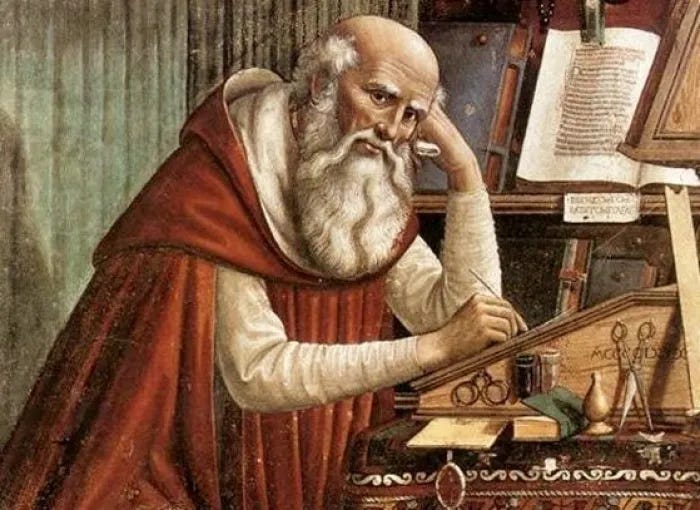The Roman Catholic church, from which all Western Christianity derives, has a unique worldview that combines Faith and Reason. This comes largely from the teachings of St. Augustine, whose writings so dominated the Latin Church that they fundamentally changed Western thought and led to the schism between the East and West.
Note, in this article I use several quotes from the excellent book Thinking Orthodox, by Eugenia Scarvelis Constantinou. I only footnote the first one, but many quotes come from Chapter 3 of this book.
Augustine was trained and educated as a philosopher and rhetorician. Later, as a bishop of the Church, he tried to resolve theological questions by the application of reason and logical deduction. Lacking a formal theological education, Augustine relied on his philosophical training. He believed that truth could not conflict with reason because God is the source of both.1 Therefore, he concluded that deductive reasoning can be utilized in the service of theology.
[…] Relying on his training in philosophy, he arrived at his own divergent conclusions to some theological questions, many of which had already been resolved by important church councils and notable Greek Fathers.2
The Catechism of the Catholic Church states:
Our holy mother, the Church, holds and teaches that God, the first principle and the last end of all things, can be known with certainty from the created world by the light of human reason.3
Catholic seminarians receive years of training in philosophy. This has led to innovations in doctrine, including a different view of original sin as inherited guilt, which led to the Immaculate Conception, the Bodily Assumption of Mary (that she did not die but was translated), Purgatory, and others. This also led to a juridical mentality that shows up in many places. For example, the Orthodox refer to their canons as the “Holy Canons,” whereas the Roman Catholics refer to theirs as “The Code of Canon Law.” This legalism is reflected in the Roman Catholic view of Sin and its removal, but also in Roman Catholic marriage, in which the language is more legalistic with vows and terms.
Original Sin
The roots of the doctrine of original sin come from St. Augustine, who in the 4th century concluded that all human beings “not only inherit mortality and the inclination to sin” from Adam, “but they are guilty and legally liable before God for Adam’s sin. This permeated Roman Catholic thought, leading to the development of the satisfaction theory of atonement4 in the twelfth century before being formalized as a Catholic dogma in the 16th century.
This view also sets up the doctrine of purgatory as a place where people must pay the punishment for their sins. This doctrine does not exist in Orthodoxy.
In a Vatican document, the “Apostolic Constitution” Indulgentiarum Doctrina: It is a divinely revealed truth that sins bring punishments inflicted by God’s sanctity and justice. These must be expiated either on this earth through the sorrows, miseries and calamities of this life and above all through death, or else in the life beyond through fire and torments or “purifying” punishments5…. These punishments are imposed by the just and merciful judgment of God for the purification of souls, the defense of the sanctity of the moral order and the restoration of the glory of God to its full majesty… That punishment or the vestiges of sin may remain to be expiated or cleansed and that they in fact frequently do even after the remission of guilt is clearly demonstrated by the doctrine on purgatory… For all men who walk this earth daily commit at least venial sins; thus all need the mercy of God to be set free from the penal consequences of sin.
This differs from the Orthodox view that the fall of Adam inclined man to sin, resulting in mortality and separation from God, much like the LDS view, but not that we must pay for Adam’s transgression.
Atonement and Redemption
Protestantism grew out of Western Catholicism and inherited this concept of sin. Martin Luther and John Calvin developed their views of atonement, based on the Catholic perspective of sin and atonement, into what’s known as the Penal Substitution theory6 of the atonement. The resulting theology does away with a need for purgatory and views Christ's death on the cross as a substitutionary sacrifice to pay the penalty for human sin and satisfy God's justice; that Christ had to ransom us by paying the debt owed to the Father - as required by justice.
This need to atone for human sin and pay the debt so that justice could be satisfied ultimately resulted in the LDS theology of the Atonement7. That God the Father
Keep reading with a 7-day free trial
Subscribe to Latter-Day Saint to Orthodox to keep reading this post and get 7 days of free access to the full post archives.




